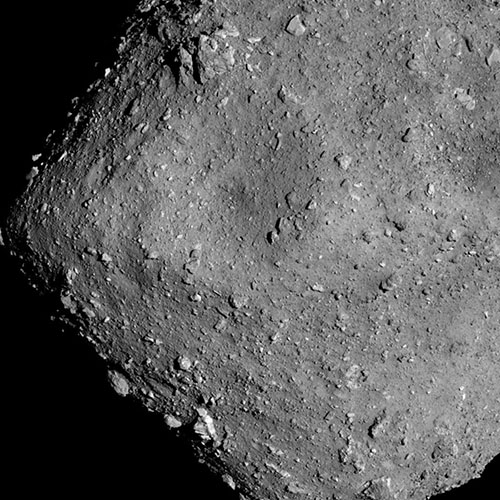Scientists led by Tohoku University, Japan have determined the formation and evolution of the asteroid Ryugu, unlocking information on its early history and that of our solar system

Samples of the asteroid Ryugu (pictured) were studied in labs at the Museum for several weeks CREDIT JAXA, University of Tokyo, Kochi University, Rikkyo University, Nagoya University, Chiba Institute of Technology, Meiji University, University of Aizu, AIST
By investigating samples returned by the asteroid explorer Hayabusa2, an international team of scientists, including Dr Ashley King and Prof Sara Russell from the Natural History Museum, have been able to study the minerology of the carbonaceous asteroid revealing its early history.
The sample return
Hayabusa2 is an asteroid sample-return mission operated by the Japanese state space agency JAXA and is the fifth ever mission to collect samples from a known object in our solar system. In December 2020 Hayabusa2 returned to Earth a capsule containing approx. 5g of sample taken from the asteroid Ryugu. The team were able to study this sample in incredible detail, almost atom by atom, in labs here on Earth, including at the Museum.
Dr Ashley King of Earth Sciences at the Museum received a combination of materials from the sample including powder, flat polished surfaces and a small chip measuring approx. 3mm. He says, ‘By investigating the minerals within small fragments of the returned samples, we’ve been able to reconstruct the 4.6-billion-year history of asteroid Ryugu. We now know that it records chemical reactions between water and rocks in the cold, outer regions of the solar system. Asteroids like Ryugu are the building blocks of the solar system and could help us understand the origin of water on Earth.’
The findings
A crucial finding of this study is the confirmation that Ryugu is a carbonaceous chondrite. Although this has long been suspected by the planetary science community, it is only through sample return missions like Hayabusa2 that there can be complete confidence. This confirmation is the baseline on which all subsequent investigations can now be formed.
Carbonaceous chondrites are primitive building blocks of our solar system and can provide answers to some of the biggest questions asked of humanity, such as how the planets formed. Hayabusa2 is the first mission to bring back samples from a carbonaceous asteroid.
The team found that Ryugu’s parent body formed very early - within the first few million years of the solar system - and formed between C02 and snow lines, the point at which it is cold enough for ice to form. Today this would fall around the main asteroid belt between Mars and Jupiter.
Based on the detection of the magnetic field in the samples studied, it is likely that Ryugu’s parent body was born of C02 ice and rock particles in the darkness of nebular gas, far from the Sun where sunlight cannot reach. However, there were also a small amount of particles present that formed in high temperatures. These had migrated from near the Sun to the outer solar system indicating high level mixing of materials in the inner and outer solar system at the time of Ryugu’s birth. Chemically, Ryugu has a very primitive make up, similar to that of the Sun, suggesting it formed from the same primordial cloud.
The asteroid’s parent body was then struck by a high-impact collision that sent it shattering into smaller pieces. Some of these pieces then joined together to create a ‘rubble pile’ which is the Ryugu we know today.
Prof Sara Russell, Merit Researcher in Cosmic Mineralogy and Planetary Sciences at the Museum says, ‘It’s been so exciting to be involved in such an ambitious mission to an asteroid and back, and we are thrilled to see the rocks brought back are close relatives to some of the precious space rocks that make up our meteorite collection in the Natural History Museum.’
The paper Formation and evolution of carbonaceous asteroid Ryugu: Direct evidence from return samples led by Prof. Tomoki Nakamura, Tohoku University, was published in Science on Thursday 22 September, 19.00 BST.
ENDS
Press office contact
Tel: 07799690151
Email: press@nhm.ac.uk
Images available to download here.
Press release from JAXA available here.
The Natural History Museum is both a world-leading science research centre and the most-visited indoor attraction in the UK last year. With a vision of a future in which both people and the planet thrive, it is uniquely positioned to be a powerful champion for balancing humanity’s needs with those of the natural world.
It is custodian of one of the world’s most important scientific collections comprising over 80 million specimens accessed by researchers from all over the world both in person and via over 30 billion digital data downloads to date. The Museum’s 350 scientists are finding solutions to the planetary emergency from biodiversity loss through to the sustainable extraction of natural resources.
The Museum uses its global reach and influence to meet its mission to create advocates for the planet - to inform, inspire and empower everyone to make a difference for nature. We welcome millions of visitors through our doors each year, our website has had 17 million visits in the last year and our touring exhibitions have been seen by around 20 million people in the last 10 years.
Contact
Weekdays: +44 (0)20 7942 5654
Evenings and weekends:
+44 (0)7799 690 151
Email: press@nhm.ac.uk
Don't miss a thing
Receive email updates about our news, science, exhibitions, events, products, services and fundraising activities. We may occasionally include third-party content from our corporate partners and other museums. We will not share your personal details with these third parties. You must be over the age of 13. Privacy notice.
Follow us on social media